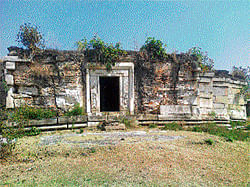
A temple in a dilapidated state on Gundlupet- Chamarajanagar road arouses curiosity, for its sheer vastness. It is believed to be in existence since the reign of the Hoysalas. The temple has undergone timely renovations, thanks to successive dynasties and their benevolent rulers.
When this reporter tried to find out the temple’s history, it was the library attached to the Department of Archaeology in the Mysore Palace premises that threw up interesting information. The Mysore Archaeological Report (MAR) of 1934 says the temple has a garba griha (sanctum sanctorum), a sukhanasi (canopy), a covered pradakshina, a large navagraha and a porch, all of which have now disappeared.
On the inner face of the second pillar to the south-west of the sukhanasi doorway, the image of a prince seated can be seen. He is evidently Chikkadevaraja Wodeyar, the then ruler of Mysore. A copper plate issued by Chikkadevaraja Wodeyar himself in 1674 AD, has an inscription which says, “the sukhanasi being the best of the lot resembles the doorway of the Vaidyeshwara Temple at Talkad, the capital of the Gangas.”
Senior journalist Echanur Kumar, who is also an authority on history, says, “The Para Vasudeva temple was part of the earlier Harikutara, now known as Chamarajanagar. The Gangas ruled the region back then. Para Vasudeva was the deity of the locals. ‘Para’ means ‘adhyatma’ (spiritual or divine)and Vasudeva means Lord Vishnu.”
Harikutara also has a meaning, Hari for shatru (foes) and kutara for hodedu haaku (kill the enemies). Though there are no precise records, the temple is known to date back to the time of the Hoysalas. Though the region was ruled by different rulers, including the Wodeyars, the temple received due patronage and was revived from time to time. What we see now is the temple that has undergone many renovations.
To support this, there is a mention of renovation in MAR of 1937. It reads, “When the temple fell into ruin, 20 years ago, its mukhamantapa was removed and built as the pata lanchana of Vijayanarayana Temple.
The images of Para Vasudeva, Lakshmi and Andal and also two groups of metallic images belonging to the temple and one stone group of Alvars were brought over and housed in the navaranga hall of the same temple.”
The salu mantapa (a series of porch-like structures) and kalyani (pond) in the front are proof that the temple attracted a large number of devotees. The structure was a place for devotees to rest and also traders to sell puja materials. The report says that the temple could possibly belong to the late Hoysala period.
What’s new is that the temple is set for major restoration work, with the Department of Archaeology taking up the task at an estimated cost of Rs 1.6 crore. Director of Archaeology R Gopal said the restoration work will be take up by next year. Apart from Para Vasudeva Temple, another historically significant Triyambakeshwara Temple inTriyambakapura, one-and-a-half miles from Terakanambi in Gundlupet taluk, is also being renovated at the same cost. According to MAR, this temple was constructed between 1250 and 1350.